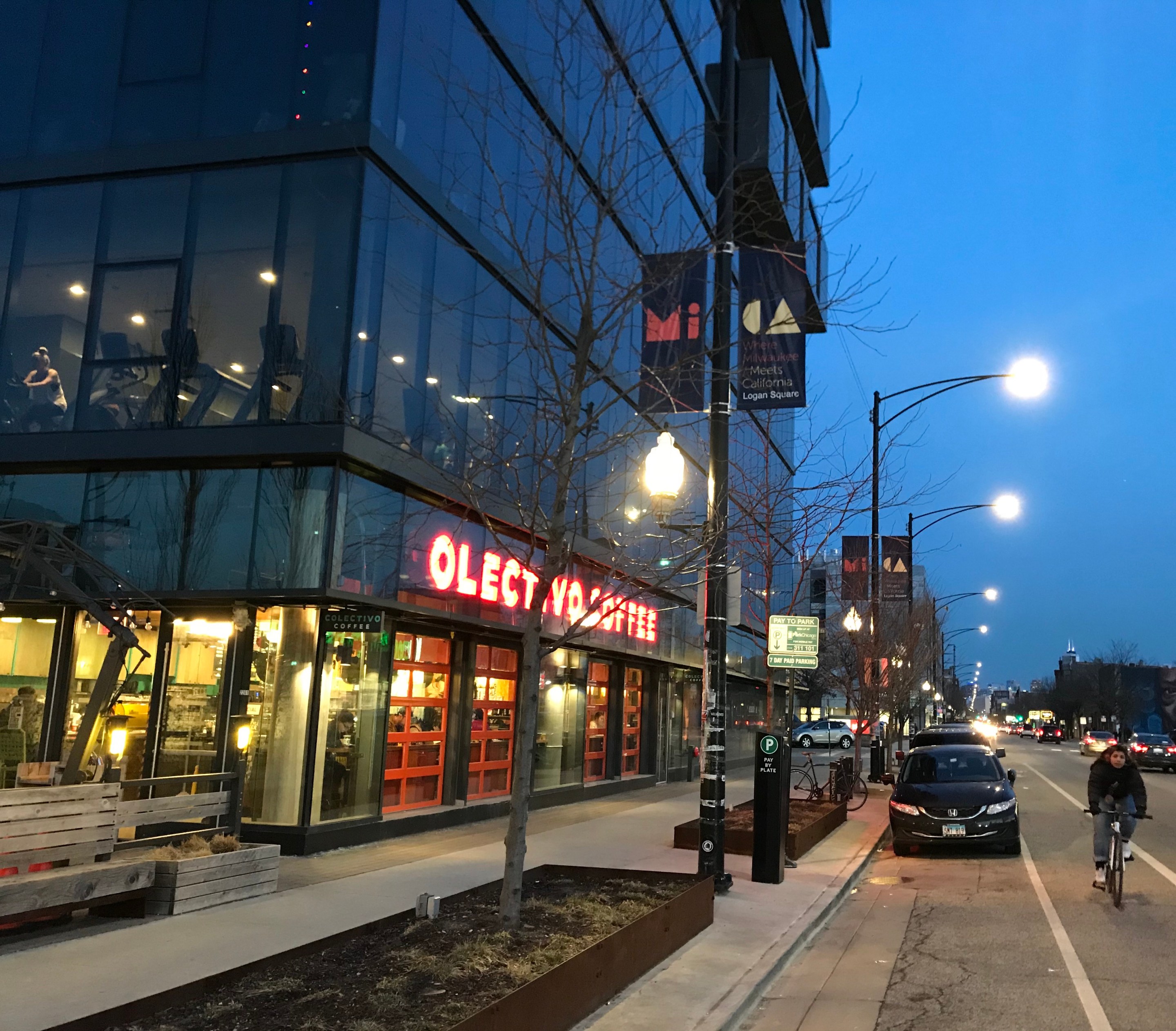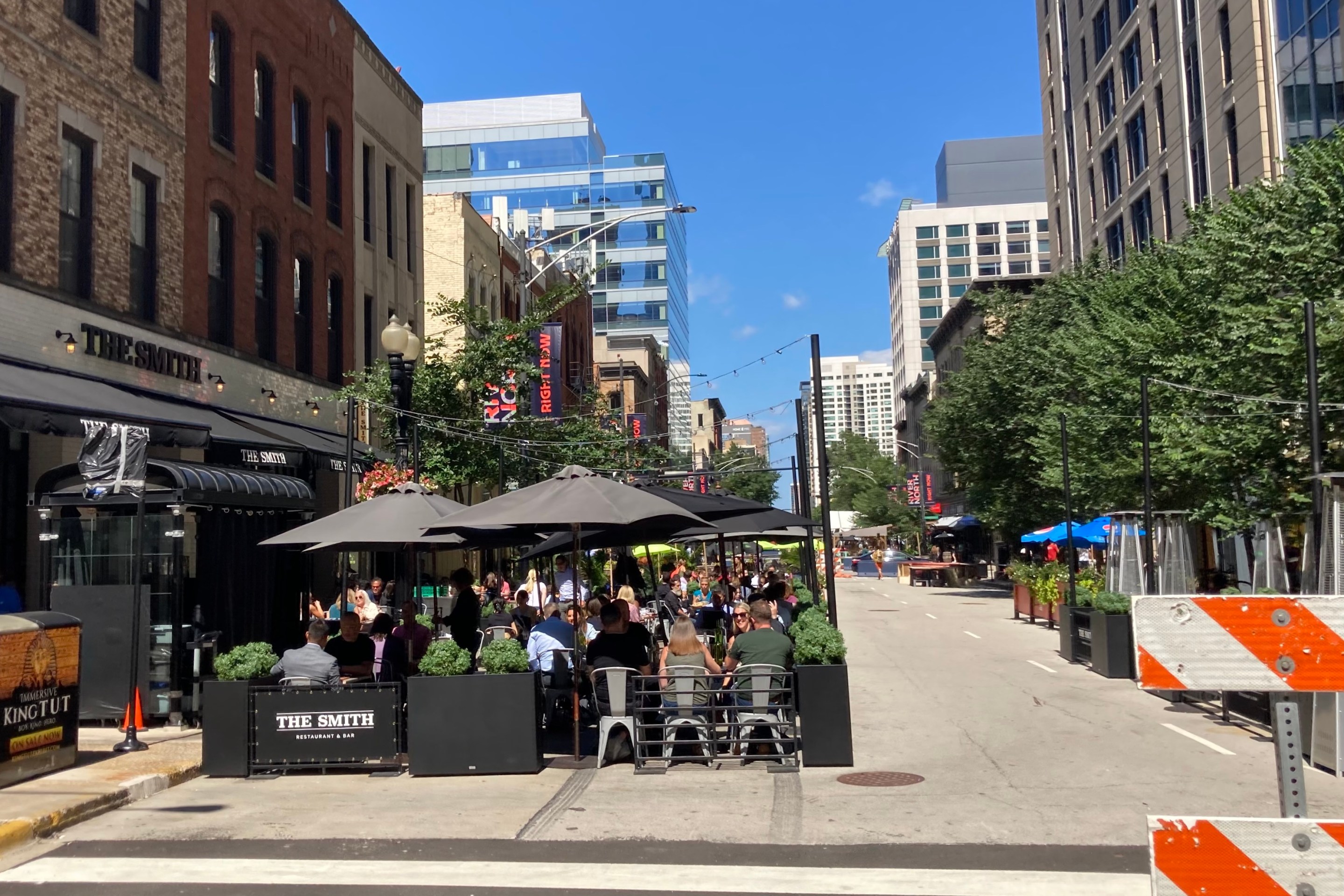Don’t be a Livable Streets Jerk
2:03 PM CDT on April 22, 2020

The MiCA transit-oriented development in Chicago’s gentrifying Logan Square neighborhood. Photo: John Greenfield
This article previously ran in the Chicago Reader newspaper.
Traffic safety and sustainable transportation boosters like myself like to believe we're on the right side of history. I’m confident that in the future more people will get behind our efforts to reduce driving and crashes, and create better conditions for walking, biking, transit, and public space.
On the other hand, urban planning and livable streets advocacy have historically been dominated by relatively privileged folks, who are typically white, male, middle class or affluent, well-educated, aren’t living with a disability, etc. As such, there have been plenty of examples of livable streets advocates having blind spots when it comes to issues impacting marginalized communities.
This has sometimes resulted in policies and projects with unintended consequences, or transportation advocacy that actually does harm. So I wanted to take a look at ways that advocates can be better allies to social justice efforts, and avoid acting like what I call a Livable Streets Jerk.
I was partly inspired by a New York City colleague's recent tweet complaining about unlicensed entrepreneurs on the Brooklyn Bridge blocking bike and foot traffic. They posted a photo of a Black coffee vendor and tagged the NYPD. After many people pointed out that the post put the vendor in danger of a potentially violent encounter with the police, the colleague acknowledged on Twitter that they'd made an error.
In fairness, I've made my share of mistakes in covering sustainable transportation issues over the years. The most important rule I've learned is to always ask myself what the potential impacts of projects and policies may be on people from various marginalized groups.
I'm talking about questions like, if we ramp up traffic policing in lower-income communities with high levels of traffic violence as part of Vision Zero—the effort to eliminate serious and fatal crashes—will that result in more racial profiling and police abuse of Black and Brown residents?
Similarly, if Chicago responds to the recent wave of violent robberies on the 'L' by deploying more police officers in the system, how do we make sure that results in a net increase in safety and comfort for all riders?

If we extend a rapid transit line, build a nifty new walking and biking path, or make it easier to build dense, low-parking transit-oriented development (all good things in a vacuum), will that jack up property values, property taxes, and rents, a phenomenon known as "environmental gentrification"? If so, how can we preserve housing affordability and prevent the displacement of longtime poor and blue-collar residents?
Is it ever acceptable for a transit agency to do a major facelift of a rapid transit station without making it wheelchair accessible?
Would increasing taxes on private Uber and Lyft rides to fight traffic congestion, as Chicago recently did, reduce the income of working-class and immigrant ride-hail drivers, or make it more expensive for women, trans people, and other at-risk individuals to feel safe while traveling home at night? If so, how can we mitigate these things?
You get the idea. If you’re a livable streets advocate, my advice is to try to avoid having blinders on about possible unintended consequences, even if they wouldn’t directly affect you. The historic failures of privileged decision-makers to see this stuff is a big reason why it's important to have all demographics represented in planning and advocacy, as well as the community input process.
Chicago leaders who fight for racial and economic justice on a daily basis shared some more thoughts on the subject. Former mayoral candidate and Austin Chamber of Commerce director Amara Enyia, who helped collect input for Vision Zero in west-side neighborhoods, notes that the potential for increased police abuse was largely off the radar of transportation officials and mainstream advocates. "Nobody thought about the implications for communities that are already struggling with over-policing."
Enyia credits Oboi Reed, who leads the mobility justice nonprofit Equiticity, with being a "crucial voice" for bringing that issue to the forefront by convincing the Active Transportation Alliance to cancel a planned Vision Zero summit with a $50 entry fee and an all-white speaker lineup.
"It's important to avoid a narrow view of what safety is," Enyia adds. She notes that while transportation advocates often focus on protecting people from dangerous drivers, mobility barriers like street crime and unfair enforcement, such as the CPD's practice of heavy bike ticketing in Black and Brown communities as an excuse for searches, are often overlooked.
"I understand that people are passionate about protected bike lanes and transit-oriented development," Enyia says. "But it's important to think about how these things fit into the existing community and do culturally and contextually relevant outreach. That's how you get buy-in and support instead of suspicion and pushback."
Christian Diaz is co-chair of Elevated Chicago, which advocates for equitable transit-oriented development (TOD), and is lead housing organizer for the Logan Square Neighborhood Association, which fights displacement. In that swiftly gentrifying northwest side community, green projects like The 606 elevated trail, and the many dense, high-end developments that have sprung up near Blue Line stations since the City Council passed ordinances facilitating TOD, have fueled housing speculation.
A study released in January by DePaul University’s Institute for Housing Studies found that home prices along the western half of the 606 have risen by nearly 344 percent since 2012. And last week the developer of Logan's Crossing, an upscale TOD that replaced the Discount Megamall, an indoor flea market that featured largely Latino vendors, announced that studio apartments will rent for a whopping $1,895 a month.
"We can't just tack on sustainable transportation amenities to the racist monster that is gentrification and development in Chicago, in a neighborhood like Logan Square that has been historically redlined," Diaz says. "We have to be mindful of how our work relates to that history. If only some neighborhoods get amenities like the 606 and nice housing near transit, there's going to be competition for space, and demographics that have been historically propped up by government policies will have an advantage. Then we're just reinforcing racial injustice."
"We need our friends in sustainability advocacy to ask themselves who projects are for, and how we can make sure the benefits go to everyone, including the people who need them the most, not just rich white people," Diaz says. He credits Active Trans with being "a great partner to LSNA" in recent years by building support for a 100-percent affordable TOD next to the Logan Square Blue station, and helping to pass an ordinance last month freezing development along the west end of the 606 for six months so that the city can come up with an anti-displacement strategy.
Diaz has one more piece of advice for livable streets fans who want to be allies, not obstacles, to social justice in Black and Brown communities. "Listen. Don't just come into our neighborhoods and tell us what we need. Hear our concerns. We bring as much to the table as transportation advocates, because I do think we're on the same team."
In addition to editing Streetsblog Chicago, John writes about transportation and other topics for additional local publications. A Chicagoan since 1989, he enjoys exploring the city on foot, bike, bus, and 'L' train.
Stay in touch
Sign up for our free newsletter
More from Streetsblog Chicago
Service boost means BNSF Line will get Metra’s first-ever across-the-board weekend schedule, starting April 29
In addition, Halsted Street station will get weekend service, and Downers Grove's Fairview stop will become an off-peak stop.
Today’s Headlines for Friday, April 19
Tasty news: Friedman Properties is trying to break the Clark outdoor dining stalemate by applying for street closure permits
Mayor Johnson's administration and Ald. Reilly haven't yet found common ground on bringing back the popular car-free zone. Will this make the difference?
Today’s Headlines for Thursday, April 18
Roger that! Streetsblog SF editor Roger Rudick offers constructive criticism of Chicago’s downtown bike network
"There were blocks that felt very safe and very secure," he said. "But then you're immediately – voom! – disgorged into three lanes of moving traffic with no protection."



